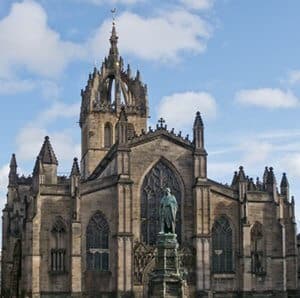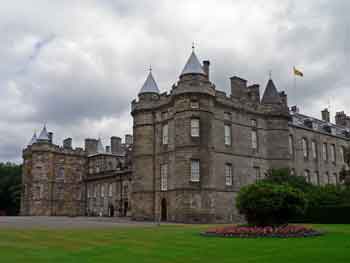George Heriot, the eldest of ten children, was born in Edinburgh in 1563 into a family of some standing.
His father, a goldsmith, was the Deacon Convenor of Incorporated Trades and as such a Commissioner for Edinburgh and Member of the Scottish Parliament.
With powerful connections, Heriot senior ensured that his most talented son received introductions to the elite of the capital’s society in preparation for him joining what the head of the family called, “The most lucrative trade in the kingdom.”
George Heriot: grey walls of St Giles’ Cathedral

In 1586, at the age of 23, Heriot was married and thanks to the generosity of his father set up his first business
Although squeezed in to a cramped space, his workshop, measuring a mere seven feet square contained a forge, bellows and other tools of his trade.
It stood against the grey walls of St Giles’ Cathedral.
Two years later he was a member of the Incorporation of Goldsmiths and his business prospered to such an extent that the aristocracy and even royalty became his best customers.
According to Robert Louis Stevenson “In one of these little shops plastered like so many swallow’s nests among the buttresses of the old Cathedral [St Giles Cathedral], that familiar autocrat James VI would gladly share a bottle of wine with George Heriot the goldsmith.”
However, the key to his dazzling future lay across the North Sea in the hands of a young Danish princess.
More Scottish biographies
In keeping with the traditions of the period, King James VI needed a suitable marriage partner and in his quest for a bride, the most eligible ladies of the European courts were all considered.
Sailed into the Firth of Forth
It was in the spring of 1590 that James and his new wife Anne, the youngest daughter of King Frederick II of Denmark sailed grandly into the Firth of Forth.
He landed at Leith amidst a fanfare of trumpets and much heraldic pageantry.
Leaving the dockside, the royal procession travelled slowly into the city passing the West Port to the sound of a loud, welcoming cannonade before progressing through the Grassmarket to the High Street and the Tolbooth.
The couple eventually reached St Giles and attended a short service.
George Heriot: goldsmith and jeweller to James VI and Queen Anne
Anne’s arrival in Scotland changed Heriot’s life. His appointment as goldsmith to the Queen was announced at the Cross of Edinburgh in July 1597. Four years later he became jeweller to the King.
With fortunes growing and surplus funds available he was often approached for financial help and became a discrete moneylender, in essence, a banker to the crown.
The state coffers were often empty and the extravagant Anne was known, on many occasions to have approached the royal jeweller for an advance of cash, pledging her most precious jewels as security.

In the ten years after she came to Scotland, and with Heriot’s expert help, she managed to spend a fortune.
With the King and Queen lavishly setting the pace their courtiers too vied with each other to see who could buy the most expensive trinkets.
Heriot rapidly becoming the richest burgess in the city was a shrewd business demanding appropriate security for any loan he made.
In 1603, for example, a document signed by the king showed that Heriot became the temporary custodian of the Royal Chapel at Stirling Castle, although exactly what he could have done with this property is debatable.
Travel from the Palace of Holyroodhouse
Even a simple journey like travelling from the Palace of Holyroodhouse to Stirling to visit her son was a problem when there was no money available.
On such an occasion Anne would write to her favourite banker, “Gordg Heriatt, I ernestlie dissyr youe send me tua hundrethe pundes…”
At the Union of the Crowns in 1603, James moved south to London and of course needed new finery and jewellery worthy of his elevated position.
A range of gold and diamond rings was quickly supplied by the royal jeweller who joined the King in London. In the English capital city, Heriot thrived.
While continuing as a goldsmith he also branched out, investing heavily in property.
Death of George Heriot
When George Heriot died in 1624 his last will and testament showed the extent of his wealth.
While substantial bequests were made to family and friends he also remembered his native city leaving the sum of £23,625 to be used to found a “Hospital and school for the education, nursing and upbringing of poor orphans and fatherless children of burgesses and freemen in Edinburgh.”
George Heriot’s School
That hospital is today the world-renowned George Heriot’s School, a grand 17th century edifice that looks down on the city’s Grassmarket.
Heriot Watt University also perpetuated his name, while Sir Walter Scott incorporated him into his novel, the Fortunes of Nigel.
Scott summed him up as, “A man of goodness of heart and rectitude of principle, and a person who has left the most magnificent proofs of his benevolence and charity that the capital of Scotland has to display.”